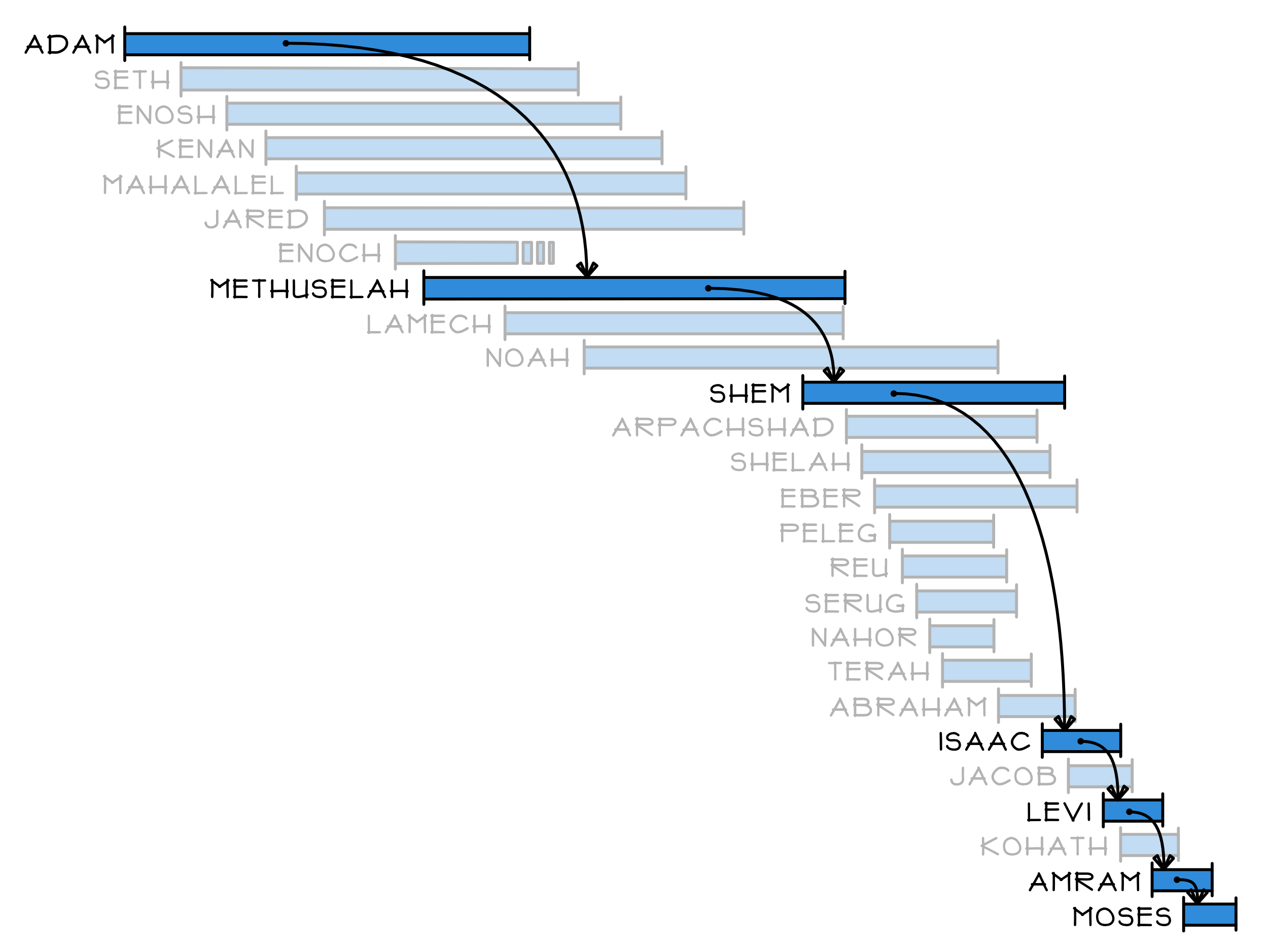Calling Long Distance
Considering how much history went by before Moses wrote Genesis, it’s tempting to be skeptical about the story. Genesis tells of a whole planet created in a week, of a perfect utopia with perfect people, and of the sea suddenly being higher than the mountains. These stories are so fantastic, people put them down as legends or myths, but perhaps those stories deserve a second look. Moses’ history is probably better than it seems.
Moses was connected to Mesopotamia and Egypt, two civilizations with some of the world’s oldest writing.1 Abraham, just 6 generations earlier, was from Mesopotamia.2 Moses was a member of the Egyptian royal family.
In Genesis, Moses doesn’t cite any sources, and we don’t know what reference material he used, but perhaps historical documents weren’t too hard to find. Maybe his family passed along clay tablets3 about life in Mesopotamia. Maybe he browsed among papyrus scrolls4 in the Egyptian royal archives. When Moses left Egypt, maybe he worked with family records from his father-in-law, a distant cousin of sorts.
This is all speculation. Maybe there were no documents. Maybe Moses only had oral history to work with. It is easy to make mistakes when passing on oral history, but Moses still had an advantage.
In writing Genesis and Exodus, Moses did an odd thing. He didn’t just write stories, he put down a specific timeline. In one place or another, Moses mentioned each of his ancestors by name, and included the ages of most family leaders when the next leader was born. By writing history that way, Moses documented his family tree, and their ages, going all the way back to the first human.5 Moses didn’t want people to know only the stories, he wanted them to know where the stories came from.
2433 years after Adam,6 Moses was born a member of the 26th generation. Lifespans before Moses’ time were long. The 25 generations preceding him each lived an average of 500 years, and generations were spaced around 100 years apart. Today, people live about 80 years and 25-35 years separate each generation. Moses used 26 generations to cover 2500 years of history. We would need over 80 generations to go that far.
Moses’ real advantage isn’t the number of generations, but how long those generations lived.
Passing a story from father to son is a dangerous thing. Every hand-off is a chance to fumble. If generations today average 30 years apart, and people live for about 80 years, 3 generations are alive at any given time. It might take 83 generations to cover 2500 years, but that doesn’t mean the story has to be handed-off 83 times. For the best chance of success, the stories could be passed directly from grandparent to grandchild with the generation in the middle acting as a referee to double-check the details. For 2500 years of history, this cuts the number of hand-offs to about 40.
Moses only needed 6.
In Moses’ family history, lots of generations were alive at the same time. If a hand-off jumped from oldest to youngest, more than one generation was usually skipped. It takes 6 steps to go from Moses to Adam, from the historian back to the first man on Earth. For all but one of those 6 hand-offs, at least one extra generation was around to double-check the details, and, in one case, there were 6.7
People can argue with Moses’ history, but he’s the only one to give the story’s pedigree, to trace back through his family tree and explain where the stories came from. Just like today, each of those 6 hand-offs was still a game of telephone played across generations, but Moses had a better signal than we do, and, in the beginning, it was God placing the call.
1. Daniels, P. T. (1996). The World’s Writing Systems. (pg. 33). Oxford University Press. Link
2. See Genesis 11:31 for reference to Abraham in Ur. For a discussion of Ur, see Nichol, F. D. (Ed.). (1978). The Seventh-day Adventist Bible Commentary (Vol. 1, p. 290). Review and Herald Publishing Association.
3. For Mesopotamian clay tablet use, see Nissen, H.J. “The Archaic Texts from Uruk.” (1986). World Archeology. (Vol. 17, no. 3. pp. 317-334.) Link
4. For Egyptian papyrus use, see Nichol, F. D. (Ed.). (1978). The Seventh-day Adventist Bible Commentary (Vol. 1, p. 31). Review and Herald Publishing Association.
5. This timeline still works even if Moses skipped some generations. Naming how old Adam was when Seth was born is constant whether Seth was his son or great-great-grandson. For an explanation of the whole timeline and a further discussion on the topic, see Jones, F.N. (2015) Chronology of the Old Testament (p. 33). Master Books.
6. We don’t know if Adam started counting his age at creation or at the first sin. Some assume Adam and Eve sinned almost immediately, but the Bible doesn’t say. The Bible only states that Adam was 130 when Seth was born. Since Seth was born after Cain and Abel had grown-up, if Adam did count his age from creation, he only had about 100 years in Eden before he ate the fruit. Alternatively, if Adam counted his age starting when he ate the forbidden fruit, as most timelines assume, then we have no idea how long he and Eve spent in Eden beforehand. Since they were commanded to “be fruitful,” and had no children until after leaving the garden, it’s plausible to think they weren’t in there very long.
7. Six hand-offs is the minimum based on how lifetimes overlapped. To reach the minimum, all the generations would need to live in the same area or meet-up when the story was passed on. The actual number of hand-offs was probably higher.
Note: The genealogy from Abraham to Moses is found in Genesis 25:19-26, Genesis 29:34, and Exodus 6:16-20. The genealogy connecting Abraham to Jethro is found in Genesis 25:1-3 and Exodus 18:1. The ages of the family leaders are scattered around and come from Genesis 5, Genesis 11:10-32, Genesis 12:4, Genesis 21:4, Genesis 26:26, Exodus 7:7, and the earlier verses about Moses’ genealogy in Exodus 6. The birth years of Kohath and Amram are estimated.




